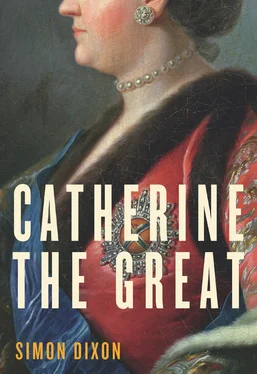50. M. V. Klochkov, ‘Nakaz imperatritsy Ekateriny II v sudebnoi praktike’, Sbornik statei v chesti M. K. Liubavskago (Petrograd, 1917), 1–18.
51. Arkhiv brat’ev Turgenevykh, vyp. 6: Perepiska Aleksandra Ivanovicha Turgeneva s kn. Petrom Aleksandrovichom Viazemskim, chast’ I: 1814–1833 gody (Petrograd, 1921), 295, Aug. 1833; Dekabrist N. I. Turgenev: Pis’ma k bratu S. I. Turgenevu , ed. N. G. Svirin (M, 1936), 245, 15 Dec. 1817; Madariaga, Politics and Culture , 236.
52. AKV , xxi: 361.
53. Karamzin’s Memoir on Ancient and Modern Russia , ed. and trans. R. Pipes (New York, 1972), 133.
54. M. M. Speranskii, Proekty i zapiski , ed. S. N. Valk (Moscow-Leningrad, 1961), 20, 140.
55. Memoirs of Countess Golovine , 35.
56. For detailed references, see my essay ‘“Prosveshchenie”: Enlightenment in Eighteenth-Century Russia’, in Peripheries of the Enlightenment , eds. R. Butterwick, S. Davies and G. Sanchez-Espinoza, Studies on Voltaire and the Eighteenth Century (2008:01).
57. Sochineniia Derzhavina , ed. Grot, iii: 211–3.
58. ‘O nravstvennom sostoianii voisk Rossiiskoi imperii i v osobennosti Gvardeiskogo korpusa’, ed. N. A. Kargopolova, Reka vremen , 1 (1995), 40.
59. A. Viskovatov, Kratkaia istoriia Pervago Kadetskago Korpusa (SPb, 1832), 35, 38, 46–8.
60. Polevoi, Literaturnaia kritika , 168–9.
61. M. A. Gillel’son, P. A. Viazemskii: zhizn’ i tvorchestva (Leningrad, 1969), 225–8.
62. A.I. Kornilovich, Sochineniia i pis’ma (Moscow-Leningrad, 1957), 211.
63. Shishkov, ‘Dostopamiatnye skazaniia’, 20; M. Al’tshuller, Predtechi slavianofil’stva v russkoi literature: Obshchestvo ‘Beseda liubitelei russkogo slova’ (Ann Arbor, MI, 1984), 36–7.
64. Sumarokov, Cherty Ekateriny Velikiia , xix, 46, 48–9.
65. Dolgorukov, Kapishche moego serdtsa , 235.
66. A. S. Pushkin, Polnoe sobranie sochinenii , 17 vols. (M, 1937–59), ix: 32, note.
67. I. I. Dmitriev, Vzgliad na moiu zhizn’ (SPb, 1895), 161.
68. Ostaf’evskii arkhiv kniazei Viazemskikh, t. 2: Perepiska P.A. Viazemskago s A.I. Turgenvym 1820–1823 (SPb, 1899), 45–6, 11 Aug. 1820.
69. A. G. Tartakovskii, Russkaia memuaristika XVIII-pervoi polovine XIX v.: Ot rukopisi k knige (M, 1991), 215, 218–9.
70. M. Mokrousova, ‘A. I. Turgenev—sobiratel’ istochnikov po istorii Rossii’, Sovetskie arkhivy , 1974: 4, 40–1.
71. See S. Dixon, ‘Pushkin and history’, The Cambridge Companion to Pushkin , ed. A. Kahn (Cambridge, 2006).
72. Khrapovitskii, 31, 13 Apr. 1787. See also A.A. Vasil’chikov, Semeistvo Razumovskikh , vol. V (SPb, 1894), 1–35; L. Maikov, Pushkin: Biograficheskie materialy i istoriko-literaturnye ocherki (SPb, 1899), 397–413.
73. Imperatorskoe russkoe istoricheskoe obshchestvo, 1866–1916 (Petrograd, 1916), 4–5, 60.
74. SIRIO , xiii: i.
75. This section draws, in revised form, on sources first discussed in my ‘Catherine the Great and the Romanov Dynasty: The case of the Grand Duchess Mariia Pavlovna (1854–1920)’, in Russian Society and Culture and the Long Eighteenth Century , eds. Bartlett and Hughes (Münster, 2004), 195–208, where further references may be found.
76. S. S. Trubachev, ‘G.P. Danilevskii: biograficheskii ocherk’, in G.P. Danilevskii, Polnoe sobranie sochinenii , 8th edn., 24 vols. (SPb, 1901), i: 44, 46, 61, 79–88; ‘Vospominaniia E. N. Opochinina’, ed. E. V. Bronnikova, Vstrechi v proshlym , 7 (M, 1990), 65; M. M. Stasiulevich i ego sovremenniki v ikh perepiske , ed. M. K. Lemke, 5 vols. (SPb, 1911–13), v: 326–7.
77. A. Bogdanovich, Tri poslednikh samoderzhtsa (M, 1990 edn.), 133, 27 Jan. 1890.
78. C.A. Stoddard, Across Russia: From the Baltic to the Danube (London, 1892), 74, 40.
79. F.-X. Coquin, ‘Le monument de Catherine II à Saint-Pétersbourg’, in Catherine II et L’Europe , ed. Davidenkoff, 21–2.
80. SIRIO , xiii: xii-xiii.
81. V.O. Kliuchevsky, Sochineniia , 8 vols. (M, 1956–9), v: 309–11.
82. Bil’basov, passim ; Dnevnik gosudarstvennogo sekretaria A. A. Polovtsova , ed. P. A. Zaionchkovskii, 2 vols. (M, 1966), ii: 260, 15 Jan. 1890; 341, 8 Jan. 1891; P. A. Zaionchkovskii, Rossiiskoe samoderzhavie v kontse XIX stoletiia: Politicheskaia reaktsiia 80-kh—nachala 90-kh godov (M, 1970), 285–6.
83. See A. Pyman, The life of Aleksandr Blok: I, The distant thunder, 1880–1908 (Oxford, 1978), 51.
84. For example, L. Zhdanov [L. G. Gel’man], V setiakh intriga: Dva potoka. Istoricheskii roman vremeni Ekateriny II (SPb, 1912); M. Evgeniia, Liubovniki Ekateriny (M, 1917).
85. Velikii kniaz’ Nikolai Mikhailovich, Russkie portrety XVIII i XIX stoletii , 5 vols. (SPb, 1905–9); J. E. Bowlt, The silver age: Russian art in the early twentieth century and the ‘World of Art’ group (Newtonville, MA, 1979), 166–7; R. Buckle, Diaghilev (London, 1979), 84–8.
86. Dnevnik V. N. Lamzdorfa (1886–1890) , ed. F. A. Rotshtein (Leningrad, 1926), 93–4, 15 Jan. 1888; 203, 24 Mar. 1889.
87. Dnevnik Polovtsova , ii: 203, 31 May 1889.
88. N. Notovich, L’Empereur Alexandre III et son entourage (Paris, 1893), 93.
89. R. Wortman, ‘The Russian empress as mother’, in The family in imperial Russia: New lines of historical research , ed. D. L. Ransel (Urbana, IL, 1978), 61.
90. Sir G. Buchanan, My mission to Russia and other diplomatic memories , 2 vols. (London, 1923), i: 175–6.
91. John Hanbury-Williams, The Emperor Nicholas II: As I knew him (London, 1922) 58, diary, 4 Oct. 1915.
92. Suvorov, Pis’ma , 204, to I. M. [José] Ribas.
93. The plant’s formal name was cardamine nivalis : see A. K. Sytin, ‘P. S. Pallas, P. I. Shangin i Ekaterina Velikaia’, Voprosy istorii estestvoznaniia i tekhniki , 2 (1997), 124.
94. Shcherbatov, 235.
95. Diderot, Mémoires pour Catherine II , ed. P. Vernière (Paris, 1966), 197–8; D. Griffiths, ‘To live forever: Catherine II, Voltaire and the pursuit of immortality’, in Russia and the World of the Eighteenth Century , eds. Bartlett, Cross, Rasmussen, 446–68.
96. Grimm, 77, 2 Feb. 1778.
97. Shcherbatov, 255, 241–5, 251–3, (241). Compare Martha Wilmot’s reflections on a present given to Princess Dashkova: ‘It was the first present she ever receiv’d from Katherine the Second, & certainly serv’d to recall the most interesting period of a friendship which then existed assuredly, as Katherine was only a Grand Dutchess; but for which sentiment they say a Crown very very rarely leaves room & I doubt whether the Great Katherine form’d an exception to the general observation.’ Russian Journals , 159, Martha’s Journal, 1 Dec. 1805 NS.
98. KfZh (1790), 160.
99. See K. Rasmussen, ‘Catherine II and the image of Peter I’, Slavic Review , 37 (1978), 51–69.
100. Cross, 322–3.
There is no shortage of primary material in translation to guide the English-speaking reader straight to the heart of Catherine’s sensibility. The latest edition of The Memoirs of Catherine the Great , ed. and trans. Mark Cruse and Hilde Hoogenboom (New York: Random House, 2005), also offers a perceptive introduction to the circumstances of their composition. No less entrancing is Love & Conquest: Personal Correspondence of Catherine the Great and Prince Grigory Potemkin , ed. and trans. Douglas Smith (DeKalb: Northern Illinois University Press, 2004). Correspondence of Catherine the Great when Grand-Duchess, with Sir Charles Hanbury-Williams and Letters from Count Poniatowski , ed. and trans. the Earl of Ilchester and Mrs Langford Brooke (London: Thornton Butterworth, 1928), gives a unique insight into Catherine’s political ambitions at the Court of Empress Elizabeth. Unfortunately it has not been reprinted. Neither is there a modern translation of the empress’s Nakaz , though two contemporary English versions have been published by W. F. Reddaway, ed., Documents of Catherine the Great (Cambridge: Cambridge University Press, 1931), and Paul Dukes, ed., Russia Under Catherine the Great: Volume 2 Catherine the Great’s Instruction (NAKAZ) to the Legislative Commission, 1767 (Newtonville, MA: Oriental Research Partners, 1977). Diderot’s pungent ‘Observations on the Nakaz ’ are translated in Diderot, Political Writings , ed. John Hope Mason and Robert Wokler (Cambridge: Cambridge University Press, 1992). While Antony Lentin, ed., Catherine the Great and Voltaire (Newtonville, MA: Oriental Research Partners), offers a selection of their correspondence in translation, the French originals are readily available in the magisterial edition by Theodore Besterman, published by the Voltaire Foundation.
Читать дальше












